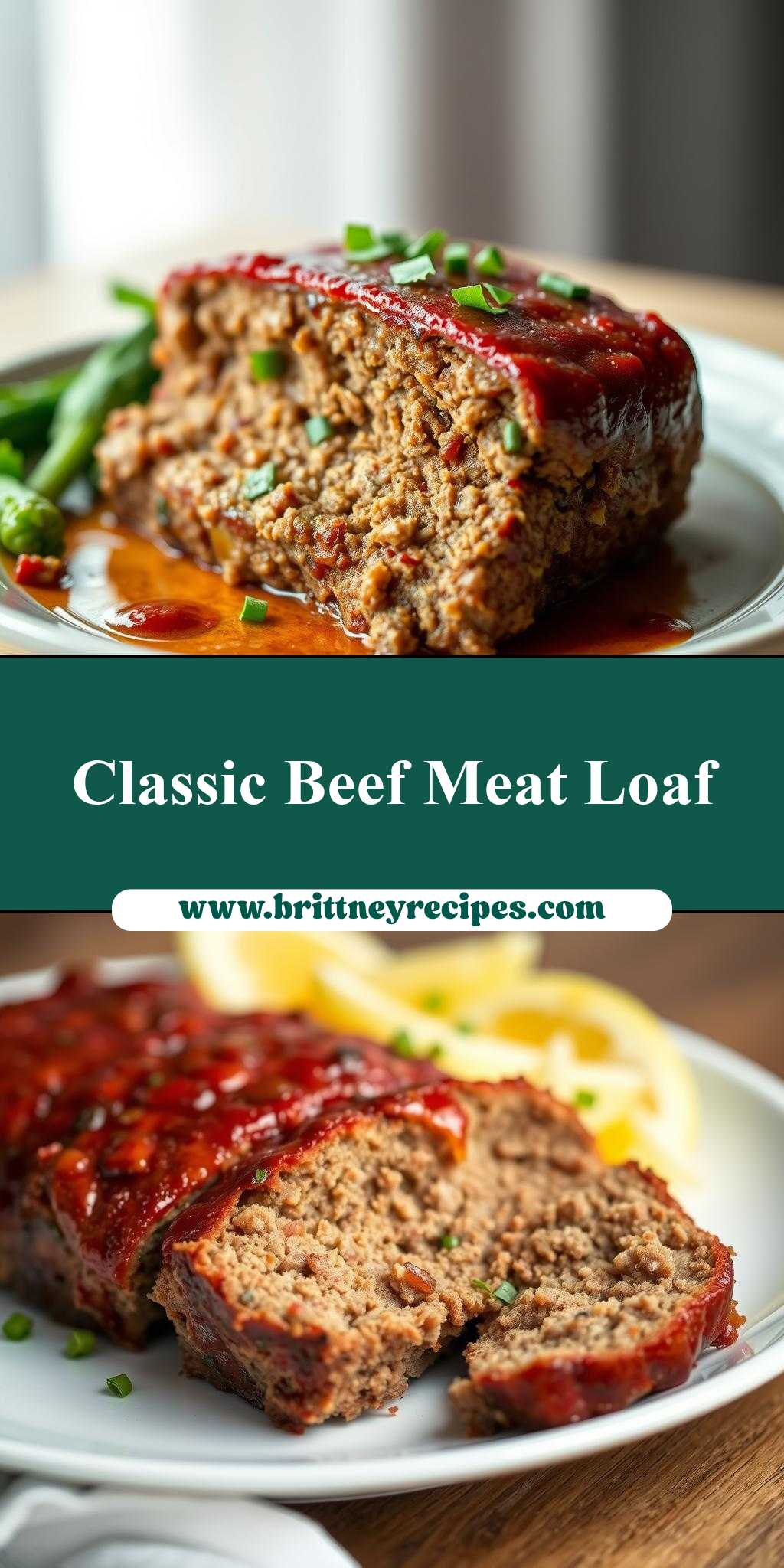What makes a perfect comfort food dish for a chilly evening? A hearty meatloaf recipe that’s easy to make and packed with ground beef and ketchup. This homemade weeknight dinner favorite is a simple yet satisfying option for a family favorite meal. Save this idea for a quick and delicious homemade meal solution.
Meatloaf Recipe
Introduction
This classic meatloaf recipe is a staple of comfort food, offering a delicious blend of flavors and textures that can be achieved with everyday ingredients. The beauty of this dish lies in its simplicity and versatility, allowing for a wide range of creative twists and substitutions to suit any taste or dietary preference. Whether you’re a seasoned chef or a beginner in the kitchen, this meatloaf recipe is sure to impress with its ease of preparation and the impressive results it yields with minimal effort.
Why This Works
- Flavor balance and ingredient accessibility: The combination of ground meat, spices, and condiments creates a rich and savory flavor profile that is both satisfying and easy to achieve with readily available ingredients.
- Ease of preparation: The steps involved in preparing this meatloaf are straightforward and uncomplicated, making it an ideal choice for weeknight dinners or special occasions alike.
- Impressive results with minimal effort: Despite its simplicity, this meatloaf recipe produces a dish that is not only delicious but also visually appealing, sure to impress family and friends with its appealing presentation and aroma.
Key Ingredients
The main ingredients in this meatloaf recipe include ground beef, onion, garlic, egg, breadcrumbs, ketchup, brown sugar, Worcestershire sauce, salt, and pepper. Practical substitutions can be made for some of these ingredients; for example, ground turkey or pork can be used instead of beef for a different flavor profile, and gluten-free breadcrumbs can be substituted for regular breadcrumbs to accommodate dietary restrictions.
Instructions
- Step 1: Begin by preheating your oven to 350°F (180°C). While the oven is heating up, chop the onion and mince the garlic. In a large bowl, combine the ground beef, chopped onion, minced garlic, egg, breadcrumbs, ketchup, brown sugar, Worcestershire sauce, salt, and pepper. Mix all the ingredients together with your hands or a wooden spoon until just combined, being careful not to overmix.
- Step 2: Transfer the meat mixture to a loaf pan or shape it into a loaf shape on a baking sheet. If using a loaf pan, make sure to leave some space around the meatloaf for even cooking. If shaping on a baking sheet, you can create a more rustic, free-form loaf.
- Step 3: Place the meatloaf in the preheated oven and bake for about 45-50 minutes, or until it reaches an internal temperature of 160°F (71°C). While the meatloaf is baking, prepare the topping by mixing ketchup, brown sugar, and Worcestershire sauce in a small bowl. After the meatloaf has baked for 30 minutes, brush the topping mixture evenly over the top.
- Step 4: Once the meatloaf is done, remove it from the oven and let it rest for 10-15 minutes before slicing and serving. This resting time allows the juices to redistribute, making the meatloaf more tender and flavorful. Serve hot, garnished with fresh herbs or accompanied by your choice of sides, such as mashed potatoes, roasted vegetables, or a fresh salad.
Handy Tips
- Use high-quality ingredients: While this recipe is forgiving, using fresh and high-quality ingredients will enhance the flavor and texture of the meatloaf.
- Don’t overmix: Mix the ingredients just until they come together. Overmixing can lead to a dense, tough meatloaf.
- Let it rest: Allowing the meatloaf to rest before slicing is crucial for retaining its juices and achieving the best texture.
Heat Control
For this recipe, maintaining the correct oven temperature is crucial. Ensure your oven is at 350°F (180°C) for even cooking. The meatloaf is done when it reaches an internal temperature of 160°F (71°C). Use a meat thermometer to check for doneness, especially if you’re not familiar with the visual cues of a cooked meatloaf.
Crunch Factor
Achieving the right texture is key to a great meatloaf. The outside should be nicely browned and slightly caramelized from the topping, while the inside remains juicy and tender. To enhance the crunch factor, you can top the meatloaf with additional ingredients like chopped bacon or a crunchy breadcrumb mixture before baking.
Pro Kitchen Tricks
- Use a mixture of meats: Combining different types of ground meat can add depth and complexity to the flavor of the meatloaf.
- Add some heat: Incorporating diced jalapeños or red pepper flakes can add a nice spicy kick to the meatloaf.
- Try different toppings: Experiment with various toppings like BBQ sauce, salsa, or a tangy glaze to change up the flavor profile of the meatloaf.
Storage Tips
- Leftover storage: Cool the meatloaf to room temperature, then wrap it tightly in plastic wrap or aluminum foil and refrigerate for up to 3 days or freeze for up to 2 months.
- Reheating: Slice the meatloaf and reheat it in the oven at 300°F (150°C) for about 10-15 minutes, or until warmed through. You can also reheat slices in a pan on the stovetop with a little oil until browned and heated through.
Gift Packaging Ideas
While meatloaf itself might not be the first choice for gifting, a thoughtful presentation can make it a lovely gesture. Consider packaging a cooled, sliced meatloaf in a decorative tin or airtight container, accompanied by a batch of homemade biscuits or a jar of specialty sauce. Add a ribbon and a handwritten note for a personal touch.
Flavor Variations
- Different spices: Try adding Italian seasoning for an Italian-style meatloaf, or use fajita seasoning for a Mexican-inspired flavor.
- Creative toppings: In addition to the traditional ketchup-based topping, consider using salsa, BBQ sauce, or a mixture of sour cream and chives for a different twist.
- Ingredient swaps: Substitute ground beef with ground turkey, pork, or a combination of the two for a lighter or more complex flavor profile.
Troubleshooting
- Texture problems: If the meatloaf turns out too dense, it may be due to overmixing. If it’s too dry, it could be overcooked or lacking sufficient moisture from ingredients like egg or breadcrumbs.
- Ingredient replacements: When substituting ingredients, keep in mind the flavor and texture they contribute to the dish. For example, using gluten-free breadcrumbs may require adjusting the amount of egg to achieve the right consistency.
- Over/undercooking signs: A fully cooked meatloaf will be firm to the touch and reach an internal temperature of 160°F (71°C). If it’s undercooked, it will feel soft and squishy. If overcooked, it will be dry and possibly cracked on the surface.
FAQs
- Can I freeze it? Yes, you can freeze the meatloaf before or after baking. If freezing before baking, shape the meat mixture into a loaf, wrap tightly in plastic wrap or aluminum foil, and place in a freezer-safe bag. If freezing after baking, cool the meatloaf to room temperature, then wrap and freeze.
- Is it gluten-free? This recipe can be adapted to be gluten-free by using gluten-free breadcrumbs and ensuring that the Worcestershire sauce and any other ingredients used are gluten-free.
- Can I double the recipe? Yes, you can double or even triple this recipe if you’re serving a larger crowd. Just keep in mind that you may need to adjust the baking time slightly for a larger meatloaf.
Conclusion
This meatloaf recipe offers a delicious and satisfying meal option that is both easy to prepare and highly customizable. With its rich flavor and tender texture, it’s sure to become a favorite in your household. Feel free to experiment with different ingredients and toppings to make it your own, and don’t hesitate to share your creations with friends and family. Whether you’re a meatloaf aficionado or just looking for a new recipe to try, this classic dish is sure to impress and delight.

